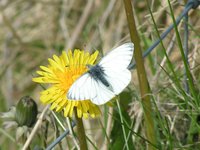Green-veined White
|
|
| Green-veined White | ||||||||||||||||||||||||||||||||
|---|---|---|---|---|---|---|---|---|---|---|---|---|---|---|---|---|---|---|---|---|---|---|---|---|---|---|---|---|---|---|---|---|
 | ||||||||||||||||||||||||||||||||
| Scientific classification | ||||||||||||||||||||||||||||||||
| ||||||||||||||||||||||||||||||||
| Binomial name | ||||||||||||||||||||||||||||||||
| Pieris napi (Linnaeus, 1758) |
Like other "white" butterflies, the sexes differ. The female has two spots on each forewing, the male only one.
Although its caterpillars feeds on crucifers, it normally selects wild species, and is therefore not the pest that some other white butterflies have become.
It can produce up to three broods in a year. Recent research has shown that when males mate with a female, they inject methyl salicylate along with their sperm. The smell of this compound repels other males, thus ensuring the first male's paternity of the eggs - a form of chemical mate guarding.da:Grønåret kålsommerfugl fi:Lanttuperhonen nl:Klein geaderd witje

